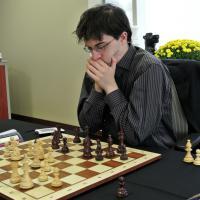
Initiative in Endgames, Part 5
As I checked out the news items that chess.com offers, one game from the Spice Cup caught my attention. The opening featured a Maroczy-bind type of structure, which I play and therefore was interesting to me but what really was interesting was the endgame rook vs. four pawns. The immediate thought was that white must be winning - the pawns were not far advanced and the white king was in their proximity. This intrigue pushed me to explore what the objective evaluation was in that position and in the overall endgame. Here, I present this endgame by dividing it into parts, each having a specific topic and plan. This article continues the series on Initiative in Endgames.
Part 1: White tries to coordinate pieces but has to sacrifice material to do so.
Balogh, who is playing white is up a pawn - this is a big material advantage for a late middlegame, early endgame. As compensation black has the annoying Nb4, a rook controlling the d-file and the super-powerful Bg7. Moreover, white's dark squares are weak and the knights on c1 and d1 need some time to get onto active squares. I would say that black has compensation for a pawn and uses this temporary initiative, which is due to better development to cash in for some material.
Part 2: How to stop the c and b-pawns from rolling?
The situation has drastically changed: white's knights got into the game and the b- and c-pawns are ready to move. What was the price for this harmonious regrouping? - An exchange. It is not a high price if you look at a scary c-pawn, which might queen in four moves. It is up to black now to decide how to fight white's initiative. I think black must exchange the Bb6 because the bishop helps the pawns to move forward and also because it is the only piece that does a good job defending weak dark squares in white's camp. Black opted for another plan: block the b-pawn from moving by a5. The drawback of this plan is that a5 is located on a dark square and white can win it after which three passed-pawns on the queenside would be extremely hard to stop.
Part 3: Tactical complications.
The next stage of the game is full of mistakes. The position is complex and it takes long lines and analysis to figure out what is happening. Black managed to exchange a few pieces but the two passed pawns still remain for white. With the black rooks active it is hard to push them forward. In the next stage of the game both sides bring their kings into the game. Black has counterplay in view of the mass of central pawns that can start moving in some lines. Vachier-Lagrave missed an excellent opportunity at the 49th move where his f-pawn could have guaranteed a draw. Overall, the struggle is typically decided in this stage of the game where there are tons of resources for each side.
Part 4: R vs. 4P, win or draw?
As the smoke cleared out white got a rook for four pawns--one might say material equality but the four pawns include doubled f-pawns and the black king is behind them. Initially, I thought that Kc4 is a mistake and felt that Kd2 or Kd3 should be better: the king would be in front of the pawns. However, here we see the topic of cutting-off the king from the passed pawns and Rb6 achieves just that!
Overall, the endgame turned out to be exciting and both sides had chances to win at some point. The rook vs. four pawns was winning for white if he could find the right idea. The next week we will wrap-up the Initiative in Endgame series.






